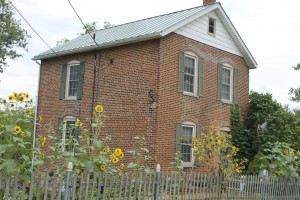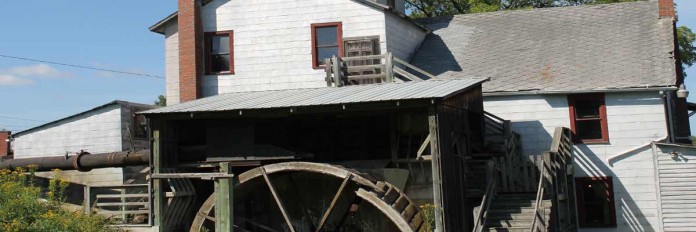MILLBROOK, Ohio — In two years, the historic Kister Mill in southwest Wayne County will turn 200. And, if enough money can be raised by a consortia, the area’s oldest industry may be around for many more years to come.
The Kister Mill is one of the few surviving mills out of the estimated 100,000 that once dotted the American landscape.
Bill Troutman, a nearby resident and former customer of the mill, said that in the heyday of milling, there were possibly as many as seven mills between the tiny burg of Millbrook, home to the Kister Mill, and Springville, a few miles to the west.
Gen. Thomas McMillan built the mill for John Nimmon who operated it as a gristmill until he sold it to Jacob Kister in 1845. Jacob converted it to a woolen mill and ran it until 1875 when Daniel Mehven bought the business and let it sit idle for six years.
Then in 1881 John A. Kister acquired it and turned it back into a gristmill.
In 1894, John added on to make it a nearly 5,000 square foot, three-story structure.
John’s son, George, helped him at the mill and eventually took over operations from his father. Then George’s son, Guy S. Kister, became the new owner in 1934.
At age 83, Guy built a new wooden 18-foot water wheel with eight spokes, 56 buckets and a 4 foot face to replace the aging 1925 wheel because he felt no one would have the skills to do so in future years.
Boyers
Guy operated the mill until 1968 when he sold it to Jim Strock and John Haloran who then sold it to the present owners, Richard and Cindi Boyer.
The Boyers are in the process of selling the mill to the Western Reserve Land Conservancy with the hope of turning it into an educational and tourist destination.
The Kister Mill, on the National Register of Historic Places, is special not only because of its age, but for several additional reasons. Remarkably, at nearly 200 years, it is still fully functional.
During its 198 years it has continuously used water power to convert raw materials into cider, cornmeal, lumber and more.
Andy McDowell, vice president, field operations for the Western Reserve Land Conservancy, explained Aug. 28 why these things are so amazing to the groups interested in preserving the mill and property.
He said that most mills specialized in making a single product and this mill is unusual because of the ability to perform multiple operations.
Hydropower
Also, by the early 1900s, nearly every water mill had been converted to more “modern” turbine power. However, the Kister Mill continued to use the more traditional method of hydropower.
When Rich and Cindi Boyer bought the mill in 1997, the 30-year-old water wheel was in such poor shape that Rich, a tool and die maker by trade, and his carpenter father Arden built a new wheel using patterns and guide boards Guy Kister had saved.
During the tour of the mill, Boyer demonstrated the mill’s diverse functionality which included the ability to press 30,000 gallons of cider per season from 10,000 bushels of apples.
He also showed the group a “flight” which is a special part used by mills. These pieces were manufactured at the Kister Mill and shipped throughout the U.S. and Canada to be used in other mills.
At various times, the mill also produced apple crates, carded wool, ground wheat flour and even chopped feed for livestock.
“Farmers would bring their corn in and let dry it for three days and two nights in the corncrib across the road until it was ready to be turned into cornmeal,” Boyer said.
Years ago, Troutman would haul logs from their woods to be sawed into lumber for projects on their farm.
“The mill has the capacity to make 100,000 board feet per year which was enough to supply 100 houses with a 30’ by 30’ floor,” Boyer said.
The former Guy and Mabel Kister residence, directly south of the mill, boasts the original woodwork and tongue and groove flooring that was especially made at the mill.

During the time the Boyers have owned the mill, they have hosted various open houses including a stop on one of the annual Wayne County farm tours. These events were always very well attended as there is a lot of interest from the community in the mill.
Selling
However, because of changing priorities, the Boyers are in the process in selling the mill, their residence (the former blacksmith shop), and surrounding land to the Western Reserve Land Conservancy who plans to partner with other organizations to operate and manage the mill.
“We are seeking funding to purchase the wooded area and the wetlands on which the mill sits and plan to protect additional adjacent wetlands and tillable farmland for future generations. We also hope to expand to contiguous property and till small fields with antique horse drawn equipment,” said Dave Kiefer, former Wayne County commissioner.
He is the driving force behind the preservation of the mill and involving organizations like the Sustainable Energy Network (S.E.N.) and The Ohio State University/Ohio Agricultural and Research and Development Center (OSU/OARDC).
“The Kister Mill represents a singular opportunity for Wayne County to showcase ‘old school’ renewable energy. If we can get the right people in line with the right vision, it could be a means to involve our students in practicums and internships. And that’s not considering the economic development potential,” said Russ Yoder from OSU/OARDC.
“The mill provides an extraordinary opportunity for artisans, philanthropists, entrepreneurs and friends to rally around it and make a special place even more so,” added Yoder.
“We plan to purchase the mill and house soon and open it up to the public as a working mill and museum. Along with the 18-foot water wheel, we’ll be offering in addition to hydropower, also geothermal, solar and wind powered projects as well. The former blacksmith shop could be a bed and breakfast.

“We would like to add a working blacksmith shop and other period businesses. We hope to offer a gift shop and visitor center with a cafe. This will be a major destination for Wayne County and northeast Ohio. It will be the only place in Ohio that can be totally operated off the grid,” said Kiefer.
In addition, tours of the mill will be an opportunity for school groups and tourists to see an authentic working mill.
“We hope to have the mill open on a limited basis sometime next year, likely by request only or for special events. Several capital improvement projects need to take place before it can be opened on a regular basis, slated for sometime in 2016 (in celebration of the 200-year anniversary of the mill). However, select internships may be available during this time to assist with such projects and to develop programming in preparation for regular operation/tours,” said McDowell.
Findings
In addition to the historical significance of the mill, there have been some natural resource discoveries on the property.
“We found two uncommon, high-quality fens. Some of the plants found at the site include the carnivorous Sundew, Queen of the Prairie, and two rare listed plants in Ohio — White Beak rush and Beeb’s Sedge, both of which are listed as potentially threatened in Ohio,” said Kate Pilacky, Firelands associate field director, Western Reserve Land Conservancy.
Donations can be made to S.E.N. of Wayne County, a 501c3 nonprofit organization.
For more information, contact Andy McDowell at amcdowell@wrlandconservancy.











I live just north of Millbrook. I would love to see this up and running! My husband grew up here and has relayed stories of the mill to me. I am also an artist. Maybe a possible art studio in or near the mill could add to interested shoppers.
My grandpa was Lloyd (Bill) Kister. I have an old school desk from the one room school in Millbrook that he attended. My mom has shared many wonderful stories of visting Her Grandma Kister in Millbrook. I am thankful to the Boyers for helping preserve a piece of history
My father was Lloyd (Bill) Kister & I spent many days with my Grandma Kister in Millbrook. My great Uncle Guy Kister’s mill was always a conversation piece & I was able to walk through it a few years ago. It would be great to see it running again!